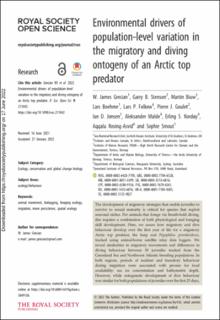| dc.contributor.author | Grecian, W. James | |
| dc.contributor.author | Stenson, Garry B. | |
| dc.contributor.author | Biuw, Martin | |
| dc.contributor.author | Boehme, Lars | |
| dc.contributor.author | Folkow, Lars | |
| dc.contributor.author | Goulet, Pierre J. | |
| dc.contributor.author | Jonsen, Ian D. | |
| dc.contributor.author | Malde, Aleksander | |
| dc.contributor.author | Nordøy, Erling Sverre | |
| dc.contributor.author | Rosing-Asvid, Aqqalu | |
| dc.contributor.author | Smout, Sophie | |
| dc.date.accessioned | 2022-06-21T07:52:35Z | |
| dc.date.available | 2022-06-21T07:52:35Z | |
| dc.date.created | 2022-04-13T13:20:18Z | |
| dc.date.issued | 2022 | |
| dc.identifier.citation | Royal Society Open Science. 2022, 9 (3), . | en_US |
| dc.identifier.issn | 2054-5703 | |
| dc.identifier.uri | https://hdl.handle.net/11250/2999731 | |
| dc.description.abstract | The development of migratory strategies that enable juveniles to survive to sexual maturity is critical for species that exploit seasonal niches. For animals that forage via breath-hold diving, this requires a combination of both physiological and foraging skill development. Here, we assess how migratory and dive behaviour develop over the first year of life for a migratory Arctic top predator, the harp seal Pagophilus groenlandicus, tracked using animal-borne satellite relay data loggers. We reveal similarities in migratory movements and differences in diving behaviour between 38 juveniles tracked from the Greenland Sea and Northwest Atlantic breeding populations. In both regions, periods of resident and transitory behaviour during migration were associated with proxies for food availability: sea ice concentration and bathymetric depth. However, while ontogenetic development of dive behaviour was similar for both populations of juveniles over the first 25 days, after this time Greenland Sea animals performed shorter and shallower dives and were more closely associated with sea ice than Northwest Atlantic animals. Together, these results highlight the role of both intrinsic and extrinsic factors in shaping early life behaviour. Variation in the environmental conditions experienced during early life may shape how different populations respond to the rapid changes occurring in the Arctic ocean ecosystem. | en_US |
| dc.language.iso | eng | en_US |
| dc.title | Environmental drivers of population-level variation in the migratory and diving ontogeny of an Arctic top predator | en_US |
| dc.title.alternative | Environmental drivers of population-level variation in the migratory and diving ontogeny of an Arctic top predator | en_US |
| dc.type | Peer reviewed | en_US |
| dc.type | Journal article | en_US |
| dc.description.version | publishedVersion | en_US |
| dc.source.pagenumber | 13 | en_US |
| dc.source.volume | 9 | en_US |
| dc.source.journal | Royal Society Open Science | en_US |
| dc.source.issue | 3 | en_US |
| dc.identifier.doi | 10.1098/rsos.211042 | |
| dc.identifier.cristin | 2017185 | |
| cristin.ispublished | true | |
| cristin.fulltext | original | |
| cristin.qualitycode | 1 | |
